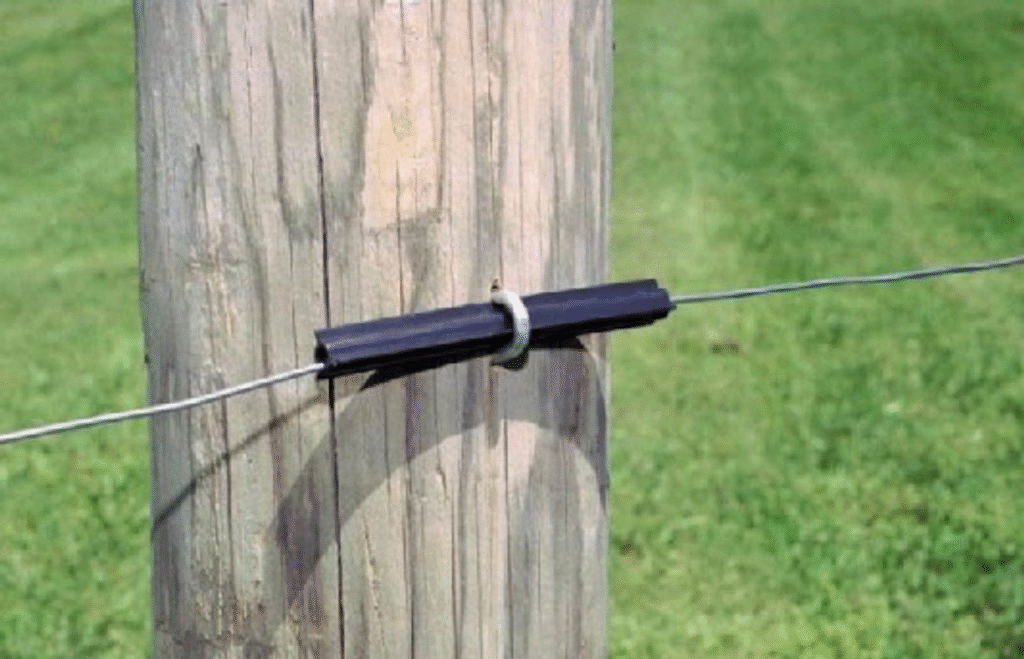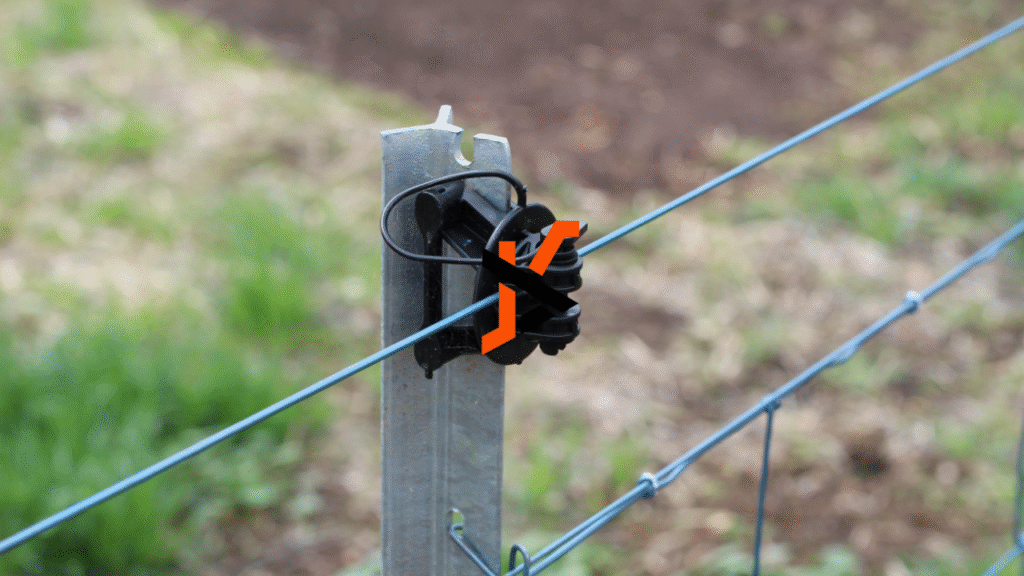Electric fence insulators are small but essential parts of any electric fencing system. They help control the flow of electricity, keeping your fence safe and working the right way. This guide will walk you through everything you need to know about electric fence insulators, including types, uses, and how to install them—written in simple words so that even a 10-year-old can understand.
What Is an Electric Fence Insulator?
An electric fence insulator is a non-conductive piece that holds the electrified wire on your fence. It stops the electric current from touching the fence post. Without insulators, electricity would travel through the wood or metal posts and into the ground, making the fence useless. Insulators are made of materials that electricity cannot pass through—usually plastic, rubber, or porcelain.
These insulators are placed between the electric wire and the post to ensure that the current stays on the wire, where it can shock animals or people that touch it. Whether you’re using a wire, tape, or rope, you’ll need the right insulator to fit your setup. They help improve the safety and function of your entire electric fencing system.
Why Do You Need Fence Insulators?
Electric fences work by sending a pulse of electricity through the wire. When an animal touches the fence, it feels a small shock that teaches it to stay away. But if the electric wire touches a wooden or metal post directly, the electricity will go into the ground. This is called a “short circuit,” and it can stop your fence from working.
That’s where fence insulators come in. They hold the wire securely and keep the electricity flowing through the wire instead of the post. This helps you:
- Keep your fence charged at full power
- Protect animals and people from faulty shocks
- Save money by reducing energy loss
- Avoid damage to posts and wires from sparks or heat
Simply put, fence insulators are a must-have for a working electric fence.
Different Types of Electric Fence Insulators
Choosing the right type of electric fence insulator is very important. There are different insulators made for different kinds of fences, wires, and posts. Using the wrong kind can reduce your fence’s effectiveness or even cause it to fail. Below are some common types:

Pin Lock Insulators
Pin lock insulators are often used on wood or T-posts. They have a small locking pin that holds the electric wire tightly in place. These insulators are strong and can handle tension from heavy wires or animal pressure. They are easy to install and remove, making them a favorite among farmers and fence builders.
Corner Insulators
Corner insulators are designed for the corners of your fence line. Corners carry extra stress because the wire changes direction there. These insulators are built stronger and are often made with higher-quality plastic or rubber. They are shaped to reduce wear and tear on the wire and prevent it from slipping out of place.
Screw-in Insulators
These insulators are made to be screwed directly into wooden posts. They are easy to install with a power drill or by hand. Screw-in insulators come in different shapes—round, U-shaped, or angled. They work well for straight runs of fence and are usually very secure. They’re also useful for fences that need to hold up in tough weather.
What Are Insulators Made Of?
Electric fence insulators are made from non-conductive materials, meaning electricity can’t pass through them. The most common materials are:
- Plastic: Lightweight, low-cost, and UV-resistant. Good for everyday use.
- Rubber: Strong and flexible. Ideal for areas with animal pressure.
- Porcelain: Very tough and heat-resistant. Best for high-voltage systems and long-term use.
Plastic is the most popular choice because it’s affordable and easy to install. However, if you’re building a permanent fence or using high-voltage wires, porcelain insulators may be worth the extra cost. They last longer and can handle more stress.
How to Put Insulators on Your Fence
Installing electric fence insulators is a simple task but must be done the right way. First, choose the correct insulator for your post and wire type. Here’s a basic step-by-step process:
- Plan your fence layout: Decide where your fence line will run and where you’ll place the posts.
- Choose your insulators: Pick types that match your post material (wood or T-post) and wire style (tape, rope, or wire).
- Attach insulators to posts:
- For screw-in insulators, drill a pilot hole and twist them in place.
- For T-post insulators, snap or clip them onto the post.
- For corner insulators, follow manufacturer instructions and use extra support.
- Thread your wire: Run your electric wire through the insulators, making sure it’s tight but not overly stretched.
- Connect the energizer: Hook up your charger to the fence, and test the system with a voltage tester.
If your insulators are not lined up or attached securely, your wire might sag or come loose, reducing the fence’s performance. Always double-check before powering on.
Best Electric Fence Insulators for Wood Posts
Wood posts are strong and stable, which makes them a great choice for electric fencing. However, they need screw-in or wrap-around insulators that can handle both wire tension and weather exposure. Here are some excellent options:

- Screw-in ring insulators: These are the most common for wooden posts. They screw right into the wood and can hold wire, rope, or tape.
- Wrap-around insulators: These are stronger and used for high-pressure zones or corners.
- Double-headed screw-in insulators: Good for multi-line fencing, allowing you to run two wires at different heights.
Best Electric Fence Insulators for T-Posts
T-posts are easy to install and widely used for temporary or semi-permanent fencing. The best insulators for these posts are designed to clip on tightly.
Clip-On T-Post Insulators
These are lightweight and simple to use. They clip directly onto the flat side of the T-post and hold the wire at a good height. Great for garden fences or small animal enclosures.
Heavy-Duty T-Post Insulators
If you’re dealing with larger animals like cattle or horses, go with heavy-duty models. These insulators are thicker, UV-resistant, and made to hold up under pressure. They usually lock into place more securely than lighter models.
How Many Insulators Do You Need?
The number of insulators you’ll need depends on how long your fence is and how many lines of wire you plan to use. Here’s a quick example:
- For a single-line fence: You’ll need one insulator for every post.
- For a multi-line fence (2 or 3 lines): Multiply the number of posts by the number of wires.
If you have 50 posts and want three lines of wire, you’ll need 150 insulators. Always buy a few extra in case of breakage or mistakes during installation.
The Bottom Line
Electric fence insulators may seem small, but they play a big role in keeping your fence working properly. Without them, your fence can lose power or even become dangerous. Whether you’re protecting livestock, pets, or crops, the right insulators will make your electric fence safer and more effective.
Choose the best insulators for your fence type—whether you’re using T-posts, wooden posts, or high-tension wire. Make sure they are made from strong, weather-resistant materials like UV-protected plastic or ceramic. And most importantly, install them carefully to avoid energy loss.
This guide was designed to be easy to follow and helpful for anyone, even if you’re just starting out with electric fences. With the right tools, a bit of planning, and good-quality insulators, you’ll have a fence that lasts for years and keeps your property safe.

